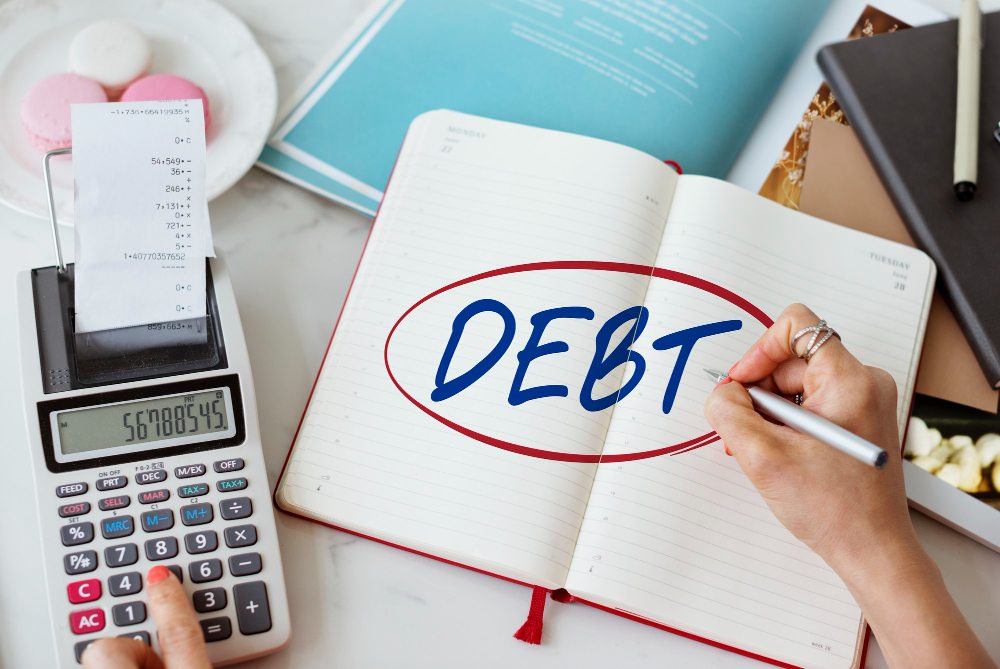For many taxpayers like you, debt comes from unexpected life changes that you never really planned for. Maybe you lost your job, got hit with a medical bill, or are just trying to keep up when prices suddenly jump higher. Debt forgiveness exists for these exact moments, when paying back everything just isn't realistic anymore.
If you've ever wondered how letting go of some debt actually works, or you want to know your real options when finances get tight, you're definitely in the right place. This blog post will walk you through what debt forgiveness is, who can actually get it, how does debt forgiveness work in practice, and what you should really consider before you make any decisions.
Read on to see what's actually possible when you need a way forward with your financial situation.
What Is Debt Forgiveness?
Debt forgiveness is basically when the lender or creditor you owe money to decides to cancel some or all of what you owe. This means you don't have to pay it back anymore. It can happen with credit cards, student loans, taxes, or other debts. The whole point is that sometimes your debt can just go away, and you get a fresh start.
The Meaning and Purpose of Debt Forgiveness
Debt forgiveness is really about helping people who are struggling with money. Here's why it matters:
- It helps people who just can't pay their bills because of things like losing their job or getting huge medical bills.
- It stops people from getting into worse money trouble, like having to file for bankruptcy.
- It gives people a chance to get their financial situation back on track.
- It tries to be fair by helping the people who really need it most.
When you apply for debt forgiveness, they're going to look at your whole financial situation. They want to see if you really can't pay what you owe. Different programs work differently, and how much debt gets forgiven depends on things like how much money you make and what kind of debt you have.
Who Qualifies for Debt Forgiveness?
Not everyone can actually get their debt forgiven. Whether you qualify really depends on your personal situation and what kind of debt you have. Here are the main things lenders and programs usually look for:
- You need to show that you're facing real financial hardship. This could be unemployment, disability, or some major life event that makes it basically impossible to pay what you owe.
- The IRS reviews your income, expenses, and what you own to see if you truly can't afford to pay back your debt.
- You might need to prove that you've made a genuine effort to pay back what you owe. This may mean making regular payments or involving your lender for help.
Each forgiveness program has its own specific rules, and this applies whether we're talking about student loans, taxes, or other debts. For example, some student loan programs require you to work in certain jobs or make payments for a set number of years before you can qualify.
How Does Debt Forgiveness Work?
Debt forgiveness helps people get relief from debts they can no longer manage. It isn’t automatic; there are clear steps to follow, and each program or lender has its own requirements.
Here’s how does debt forgiveness works:
Application Process and Eligibility Criteria
If you’re thinking about debt forgiveness, here’s what you can expect:
- Reach out to the right place: Start by contacting your lender, loan servicer, or the agency that runs the forgiveness program. For federal student loans, this is usually the U.S. Department of Education or your loan servicer.
- Gather your documents: You’ll need to show proof that you’re struggling financially. This might include pay stubs, tax returns, unemployment records, or medical bills.
- Fill out the application: Each program has its own forms. For example, if you’re applying for Public Service Loan Forgiveness, you’ll need to submit an employment certification and proof of qualifying payments.
- Wait for a decision: Once you submit everything, the lender or agency reviews your application and the documents you provided. They’ll decide if you meet their criteria.
- Get the results: You’ll be told if you’re approved or denied. If approved, you’ll find out how much debt is forgiven and what to do next. If denied, you might be able to appeal or look into other options.
What makes someone eligible?
- You must show that paying back your debt would cause real financial hardship.
- Most programs focus on unsecured debts, like student loans or medical bills.
- Each program has its own rules. For example, student loan forgiveness might require a certain number of years in public service, while IRS tax debt relief has income and debt amount limits.
- Your income, expenses, and assets are reviewed to make sure you truly need help.
Debt Forgiveness vs. Debt Settlement vs. Bankruptcy
When you’re overwhelmed by debt, there are a few different paths you can take. Here’s a simple breakdown of how debt forgiveness, debt settlement, and bankruptcy compare:
| Feature | Debt Forgiveness | Debt Settlement | Bankruptcy |
| What happens | The lender erases part or all of your debt. | You negotiate to pay less than you owe. | The court wipes out or reorganizes your debts. |
| Who decides | Lender or government program. | You and your creditor agree. | Bankruptcy court. |
| Who qualifies | Must meet strict program rules. | Usually, you need a lot of unpaid debt and financial hardship. | Must pass a means test; the court reviews your finances. |
| Impact on credit | Can lower your score? | Hurts your score; stays on report for 7 years. | Serious, long-lasting impact (up to 10 years). |
| Taxes owed? | Forgiven debt may be taxed. | The forgiven amount may be taxed. | Discharged debts are usually not taxed. |
| Legal protection | None. | None. | The court protects you from creditors. |
Choosing the Right Path: Which Debt Solution Fits Your Situation?
After looking at the key differences between debt forgiveness, debt settlement, and bankruptcy, it’s important to understand when each option might make sense for you:
- Debt Forgiveness: Good if you qualify for a formal program, like student loans or IRS tax forgiveness.
- Debt Settlement: Can help if you have some money to offer and want to avoid court, but it still affects your credit.
- Bankruptcy: A last resort for when you can’t pay your debts at all and need legal protection, but it has the most serious impact on your credit and finances.
If you’re still feeling uncertain about how does debt forgiveness works in your case or which debt option is right for you, you don’t have to figure it out alone. Mr. Michael Sullivan, a former IRS agent, and his experienced team are here to help you understand your choices and guide you toward the best solution for your situation.
Types of Debt That Can Be Forgiven
Not every debt can be wiped away, but there are several major categories in the U.S. where forgiveness is possible. This section is here to show you what kinds of debt can be forgiven, so you can quickly see if your situation might qualify.
- Student loans: Federal student loans may be forgiven if you work in public service, make payments based on your income for many years, or teach in low-income schools. Programs like Public Service Loan Forgiveness (PSLF) and Income-Driven Repayment (IDR) are the most common. Private student loans are much harder to have forgiven, but some lenders may cancel the debt in cases of permanent disability or death.
- Tax debt: If you owe more in taxes than you can pay, the IRS may let you settle for less through programs like Offer in Compromise or the Fresh Start Program, especially if you can show true financial hardship.
- Medical debt: Nonprofit hospitals must provide financial help to patients with low income or large medical bills. Some states and charities also step in to buy and forgive medical debt for people in need. As of 2025, most medical debt is no longer listed on credit reports, which helps many Americans recover financially.
- Credit card debt: If you’re struggling, credit card companies might agree to forgive part of your balance after you negotiate a lump-sum payment. There are no government programs for credit card forgiveness; these deals are made directly with your lender or through a settlement company.
- Mortgage and foreclosure relief: Sometimes, after a short sale or foreclosure, the lender may forgive the remaining balance you owe. You might also qualify for a temporary pause on payments or a change to your loan terms, especially if your mortgage is government-backed and you’ve been affected by a disaster. In some cases, the government may pause foreclosures entirely in disaster-hit areas.
- Personal loans: While less common, some lenders may forgive part of a personal loan if you can prove you’re unable to pay, often after negotiation or settlement.
Each type of debt forgiveness has its own rules and steps. If you’re not sure where your debt fits, it’s smart to review the details or talk to a financial expert for guidance.
Debt Forgiveness Programs: How to Access Real Help
Having figured out what type of debt can be forgiven, the next question is how to get help. This section is all about programs and organizations that offer forgiveness, so you're aware of where to go and what to do.
Government-Sponsored Programs
Government programs are established to assist individuals in unique circumstances. Each program is operated by a federal agency with its own procedure:
- Federal student loan cancellation: Initiatives such as Public Service Loan Forgiveness (PSLF) and Income-Driven Repayment (IDR) are for individuals employed in the public service, teaching in specific schools, or making income-based payments for several decades. The Department of Education operates these initiatives, and both have well-defined application steps.
- IRS tax relief from debt: If you are unable to pay your entire tax amount, the IRS provides options such as the Offer in Compromise and the Fresh Start Program. These allow you to pay less or establish a payment plan, but you must demonstrate financial hardship and complete the proper forms.
- Mortgage help: If you're having trouble paying your mortgage, particularly following a disaster, government-backed initiatives can allow you to suspend payments (forbearance), modify your loan terms, or even briefly halt foreclosures. These safeguards are intended to provide families with time to recover.
- Small business relief: The Paycheck Protection Program (PPP) loan forgiveness was established to provide relief to small businesses in difficult times. If you spent the funds as directed, you may be able to avoid repaying the loan.
Nonprofit and Private Sector Options
Assistance comes not only from the government. There are, in fact, nonprofit organizations and certain private corporations that can also assist you in managing or paying off your debt:
- Debt management and credit counseling: Well, non-profit organizations can essentially consolidate all your various debts into one single monthly payment. They typically are able to negotiate a lower interest rate, which also makes it easier to keep up with your payments.
- Debt settlement: Some nonprofits and private businesses will actually approach the individuals you owe and negotiate with them. They attempt to have them waive some of what you owe, particularly if you are already behind on payments and truly wish to avoid bankruptcy. Make sure to research their reputation and fees before joining with them, however.
- Medical debt forgiveness: Let's see, here's an interesting fact; not-for-profit hospitals are, in fact, legally mandated to give financial assistance to qualifying patients. And there are even some charities that'll purchase medical debt and simply wipe it out for those who can use it.
Every program is also going to have its own particular rules and procedures, whether it's a government program, a nonprofit, or a private corporation. The point is, the best way to go is really the one that fits what you need. So if you're unsure about something, you shouldn't be afraid to ask questions or seek advice.
Pros and Cons of Debt Forgiveness
Debt forgiveness can be a practical solution if you’re having trouble keeping up with certain debts, but it’s important to understand both the advantages and the possible downsides. Here’s a clear look at what you can expect, using straightforward language that’s easy to follow.
Pros of Debt Forgiveness | |
| It reduces what you owe When the lender forgives part of your debt, the amount you have left to pay gets smaller. This can make your monthly payments much easier to handle and help you avoid falling further behind on everything. | It helps avoid defaults and collections By lowering your debt, forgiveness can keep you from defaulting on your loans or having to deal with collection calls and legal action from creditors. |
| It improves your monthly budget With less debt hanging over you, you might have more money available for everyday expenses. This makes it easier to actually keep up with your regular bills. | It's an alternative to bankruptcy Sometimes, debt forgiveness lets you resolve what you owe without having to file for bankruptcy, which can have more serious and lasting effects on your credit and overall finances. |
| It can be tax-free in certain situations Some federal programs, like specific student loan forgiveness options, allow forgiven debt to be excluded from your taxable income, at least through 2025. | It gives you a chance for credit recovery If you manage your finances well after your debt gets forgiven, your credit score can gradually improve as you pay down what's left and avoid missing more payments. |
Cons of Debt Forgiveness | |
| It has possible tax consequences In many cases, the IRS treats forgiven debt as taxable income. This means you might owe more in taxes unless you qualify for an exception, such as with some student loan programs. | It can hurt your credit score Debt forgiveness, especially if it involves settling for less than you owe, can lower your credit score. This negative mark can stay on your credit report for up to seven years, making it harder to borrow in the future. |
| It has no guarantee of approval Lenders don’t have to forgive your debt. Many applications are denied, and approval depends on your financial situation and the lender’s own rules. | It has strict requirements and paperwork Most programs ask you to prove financial hardship and fill out detailed forms, which can take time and be difficult to complete. |
| It has fees and risks with settlement companies If you use a debt settlement company, you might face high fees, and there’s a risk of scams. Not all companies are trustworthy, so it’s important to do your homework. | It doesn’t solve the root problem Debt forgiveness might help with your current debt, but if you don’t address the habits or issues that caused the debt, you could end up in the same situation again. |
Alternatives to Debt Forgiveness
If forgiveness of debt is not suitable, there are other practical methods to resolve outstanding balances. In the following, there is an analysis of the most prevalent methods so that you can examine what would be most advantageous for you.
Debt Consolidation
Debt consolidation refers to merging multiple debts, like credit cards, hospital bills, and personal loans, into a single new loan. The debt holder then only has to make one payment per month, which can be highly convenient.
- Easier to monitor: One payment to make is less stressful than coping with multiple bills.
- Possibly lower interest rates: Your debt may actually be less in the long run if you are eligible for better rates.
- Clear payoff schedule: Many consolidation loans come with a clear timeline, so you know exactly when you will be debt-free.
Keep in mind that to qualify for the best interest rates, you normally need to have a good credit score, and it is a good idea not to take on further debt while paying off the consolidation loan.
Debt Management Plans
In most cases, a nonprofit credit counseling organization will establish a debt management plan. With such agencies, interest rates can be negotiated, and unsecured debts such as credit card balances can be merged for a single monthly payment.
- Counselor’s advisory: A counselor will assist you with structuring an achievable budget, which will necessitate an extensive review of your finances.
- Reduced interest and fees: Creditors might agree to lower rates and shed some fees.
- Single payment each month: The agency settles your debts with your creditors, so you only need to make a single payment to the agency.
The majority of DMPs (debt management plans) last between three and five years. You might be required to close your credit cards for the duration of the plan, which will affect your credit score; however, this is a small price to pay to have a roadmap that leads to eliminating your debt.
Negotiating with Creditors
Sometimes, talking directly with your creditors can lead to better terms or even a settlement for less than you owe.
- Ask for lower rates: If you’ve been a reliable customer, your lender might reduce your interest rate.
- Set up a payment plan: Creditors may be willing to adjust your payments to fit your budget.
- Temporary relief: In tough times, you might qualify for a pause or reduction in payments.
If you try to settle a debt for less than the full amount, be aware that this can affect your credit score and sometimes has tax consequences. Always keep records of your conversations and agreements.
What Matters Most About Debt Forgiveness?
There’s no shortcut or one-size-fits-all answer when it comes to moving on from debt. But what really matters, more than the amount you owe, the unfiled tax returns you may still need to address, or the details of a program, is how you approach what comes next. Debt forgiveness isn’t just about erasing a balance. It’s about unlearning old stress, taking a breath, and making thoughtful choices to rebuild.
Forgiveness, settlement, or any other relief option is just one moment in a bigger process. True financial relief happens when you pause, get honest about your situation, and take a step, however small, toward a more manageable, less stressful future.
Whether you’re just exploring your options or feeling weighed down by decisions, know that you have the power to create a new chapter. If you want clarity or trusted help along the way, get in touch with Mr. Michael Sullivan and his experienced team. They are always here, ready to guide you toward a fresh financial start when you decide it’s time.
FAQS
Q1. Can debt forgiveness be reversed or revoked after it's granted?
Most of the time, once your debt is officially forgiven and you’ve met all the requirements, the decision is final. However, forgiveness can be taken back if it turns out you gave false information on your application or if you stop meeting ongoing requirements.
For example, with student loan forgiveness, if you leave a qualifying job too soon or don’t follow the program’s rules, the forgiveness could be revoked and the debt reinstated. It’s important to keep records and make sure you continue to meet any conditions tied to your forgiveness program.
Q2. How long does the debt forgiveness process typically take?
The time it takes depends on the type of debt and the program:
- Student loan forgiveness: Some programs, like Public Service Loan Forgiveness, require at least 10 years of payments. Others, like income-driven repayment forgiveness, may take 20–25 years. Once you apply, it can take a few months for your application to be reviewed.
- Tax debt forgiveness: The IRS Offer in Compromise process often takes between four and nine months, depending on your case.
- Credit card or medical debt settlement: Negotiations can take several months, but the process moves faster if you have all your paperwork ready.
Always check the timeline for your specific program and keep in touch with your lender or agency to stay updated.
Q3. Are there any industries or professions that have special debt forgiveness programs?
Yes, some jobs come with unique debt forgiveness benefits:
- Public service workers: Employees of government and qualifying nonprofits may be eligible for Public Service Loan Forgiveness.
- Teachers: Those who work in low-income schools can qualify for Teacher Loan Forgiveness or Perkins Loan Cancellation.
- Healthcare professionals: Some doctors, nurses, and other medical workers may get forgiveness or repayment help if they work in high-need areas.
- Military members: There are special forgiveness and repayment programs for those serving in the armed forces.
These programs usually have specific requirements, such as working a certain number of years in the field or in designated locations.
Q4. Can I apply for debt forgiveness if I've already filed for bankruptcy in the past?
Yes, you can still apply for debt forgiveness even if you’ve filed for bankruptcy before. Approval depends on the type of debt and the rules of the program you’re applying to. Some programs may review your bankruptcy history as part of their decision, and certain debts (like federal student loans) are rarely discharged in bankruptcy, so forgiveness programs may still be available to you afterward. Always check the eligibility details for the program you’re interested in.
Q5. How does debt forgiveness affect my ability to obtain loans or credit in the future?
Debt forgiveness can affect your credit in a few ways:
- Credit score: If your debt was settled for less than you owed, your credit score may drop, and the record can stay on your report for up to seven years.
- Getting new credit: Lenders may see forgiven or settled debts as a sign of financial trouble, which can make it harder to get approved for new loans or may mean higher interest rates.
- Long-term outlook: If forgiveness helps you get back on track and you manage your finances well afterward, your credit can recover over time.
It’s a good idea to monitor your credit report after any debt forgiveness and take steps to rebuild your credit if needed.




